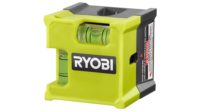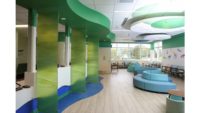Concise Precision

Lasers have been in use in the construction industry for many decades. The first rotating laser—developed in Dayton, Ohio in the mid-1960s—was used in agricultural applications to install corrugated plastic drainage tubing to more effectively remove water from farmland. Other applications quickly followed in the construction industry. The first use for interior applications was primarily for installing acoustic drop ceilings.
The History of Lasers
The laser itself was a relatively new invention, introduced in 1960. A fun fact, in case you did not know, is that the word laser is an acronym for “light amplification by stimulated emission of radiation.” The source of the initial lasers were helium-neon tubes, often referred to as HeNe lasers. These were relatively low-powered visible lasers in those days compared to industrial applications, but would be considered high-powered compared to today’s lasers. They were used in both interior and exterior construction applications. Although wonderful devices for enhancing productivity, the helium-neon tube lasers had some drawbacks. The instruments were bulky and heavy, requiring wall mounts and bracketry to provide structural support. They required high power input, requiring a separate power-converter box plugged into a 120V outlet or a fully charged car battery. They were manually leveled and prone to mechanical errors. But still, the productivity enhancements of 25 to 50 percent outweighed all the negatives. Back then, they cost in the range of $7,500 but were still widely adopted.
 The first rotating laser, invented in Dayton, Ohio
The first rotating laser, invented in Dayton, Ohio
Since then, lasers have come a long way and their design has vastly improved. The 1970s introduced self-leveling and split-beam optics for 90-degree layout work. The 1980s incorporated internal power supplies. In the 1990s, the biggest advancement was achieved with the introduction of laser diodes. The life span of a laser diode is typically 30,000 hours compared to a 300-hour life span of the early helium-neon laser tubes and, for the first time, heat dissipation was not a problem. Initially, there were issues with the laser diodes, including beam strength and optical performance, but the diodes were part of the advancing times in the electronic revolution. Increased availability and lower costs kept the industry moving forward.
Laser Diodes
The introduction of the laser diode led to their proliferation in the laser market, largely due to their lower cost and ability to operate on rechargeable or alkaline batteries. The lower technology thresholds opened the door for a variety of small laser companies. This also changed the distribution models from primarily “laser specialist” companies to the various distribution channels we see today, including construction supply stores, professional tool stores and the big box DIY stores for consumer-level products.
Today, most commercial construction lasers incorporate a laser diode. They were used then and now for various positioning projects in the commercial construction, residential and remodeling industries. Lasers are used in lieu of string lines, plumb bobs, levels, optical instruments and other tools so the user’s hands are free to perform the work required to increase productivity. The laser tools are used to reference level, plumb, square, and various alignment and layout tasks. Typical applications are ceiling and floor installations, four-foot marks, wall layout, vertical alignment, window and door cutouts, partitions and soffits, and MEP tasks.
 A manually leveled rotating diode laser, powered by alkaline batteries.
A manually leveled rotating diode laser, powered by alkaline batteries.
Red-Beam vs. Green-Beam Lasers
Initially, except for the very first ones, all interior lasers were visible red-beam rotating lasers. The rotation could be stopped to provide a point, or scanned in a small area to provide a concentrated line. With the advent of the laser diode, the types of interior laser tools have proliferated. Specialty lower-cost pointers and line lasers were developed and primarily used in the mechanical, electrical and plumbing trades. Subsequently, combination tools that incorporated rotation, lines and points were introduced. Laser receivers typically worked with rotating lasers to provide elevation information in bright environments or to extend the versatility of the laser in exterior work. Line lasers can now work with receivers that have special electronics, or the laser can be pulsed to simulate rotating on and off cycles.
The late-1990s saw the introduction of green-beam lasers. Initially, the green beams had some issues, primarily heat and power consumption. However, like some problems of the first lasers, electronic advancements have overcome these issues for the most part. Green beams have become popular because they are up to four times more visible to the human eye and are ideal for interior construction projects, where there is bright ambient light. Red-beam lasers still offer the value proposition of a lower initial price and typically have longer battery life.
Although green beams do have the physical properties of being four times brighter to the human eye, it does not necessarily translate to working at four times the distance of a red beam laser, in spite of some mixed marketing messages. The green beams typically can be seen further in bright conditions, but not four times the distance. Green-beam lasers are especially vibrant in dark environments – they provide a laser light show on the walls and ceilings!
Lasers Today
Lasers on job sites have become ubiquitous. Walk the floor of any interior construction site and you may see various pointers, line lasers and rotators of various colors – both beams and brands. Increased laser productivity mostly benefits interior construction professionals. That includes ceiling installers, mechanical, electrical and plumbing trades, framers, drywall contractors, carpenters, shop fitters, general contractors and anyone with positioning requirements.
Contractors today do not ask if they need a laser or not; they ask which laser is best for them. Common concerns or items to check are accuracy, usable distance, operating features, durability, reliability, warranty, service and dealer support. Doing your homework will pay off. The bottom line is lasers will definitely add productivity to your job site.
Looking for a reprint of this article?
From high-res PDFs to custom plaques, order your copy today!






